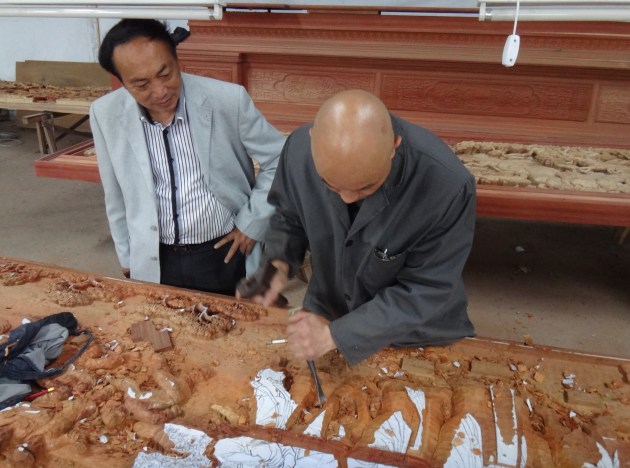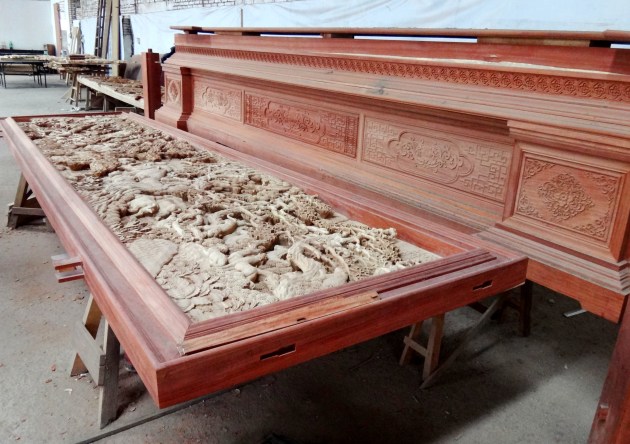Chinese woodcarving: A tale of a great master
Words and photos: Terry Martin
In China woodcarving is highly respected and incredibly well done. It is found in both traditional and modern homes, ancient temples, restaurants, hotels, offices and in the lobbies of towering corporate edifices. It is so diverse that trying to describe it is like trying to describe the Chinese landscape itself — so rich and so varied that it is difficult to know where to begin.
When I first travelled to China in 2012, I quickly saw that carving was the most interesting form of creative Chinese woodwork and I have since returned several times to learn more. This journey of discovery has been made with the help and support of the International Wood Culture Society, a not-for-profit that promotes all things related to wood culture around the world. In particular, I owe everything to work of Su Jinling, the General Secretary of IWCS, an indefatigable friend and colleague.

A partly finished traditional scene
With her help I have learned that one common thread unites all carvers across China: the hierarchy that dominates training and production at all levels. At the top of this hierarchy are the great regional masters and I have been privileged to become acquainted with perhaps the most senior of all of them, Master Feng Wentu. Master Feng comes from Dongyang, known as the main centre of wooden sculpture in China with at least one thousand years of history behind it.
Master Feng is a legend in his field. He has remarkable design and technical skills and has produced thousands of pieces on traditional themes, often interpreted in very original ways. But there is also a mischievous and playful quality about his work that helps explain why he has also been respected as a renowned innovator. That in itself is highly significant because Chinese carving is powerfully influenced by tradition and formality, so change is not easily accepted.

Twelve Beauties from the famous book Dream of Red Mansions.
This is well illustrated by an exchange I had with a group of carvers from Master Feng’s region, Dongyang, south of Shanghai. Carvers in this area use a very distinctive club-headed mallet which has one angled face that never seems to be used. When I asked why their mallets were shaped like that, the answer was, ‘because that’s the way it’s always been’. When I persisted with the question, there was a long consultation and the answer came, ‘because that’s the way it’s supposed to be!’.
If you ask enough questions like this you soon learn that it is considered very unusual to question tradition, so it is best to accept that changing the rules is not easy. Paradoxically, however, it can lead to great fame, and that is what happened to Master Feng.

Xi Man Tang, or Full of Happiness
I learned how this happened when we visited both his commercial outlets and his studio last year. A master carver in China is often head of a large commercial enterprise and Master Feng is a very successful man. But this success did not come overnight. After graduating from a famous sculpture school in 1960 when he was 18, Feng Wentu showed enormous promise, so he was sent to work under Zijin Huang, who was the most honoured Chinese wood sculptor. In China, the path to success is easier if you have the help of an honoured master.
Young Feng Wentu then went on to study at the China Academy of Art where he finally was recognised as Master of Arts and Crafts. This was at the height of the Maoist era, so he was beginning his career in the middle of political upheaval and revolutionary fervour. He had to negotiate a tricky political path and even spent an obligatory period working among the peasants in support of the prevailing socialist ideology.

Master Feng’s carving done in the politicised style of the Maoist era. Jiao Yulu, the faithful party Secretary, inspires the peasant farmers.
However, because of his careful negotiation of this period, by the time China changed course and began to support the idea of free enterprise, Master Feng was well-placed to take advantage of the new opportunities. Using his mastery of the deep relief carving style of his region he often created works based on traditional scroll paintings depicting moments of importance in Chinese history and legend.
I saw many wonderful examples of Master Feng’s work when we visited a huge sculpture museum in Dongyang that was dominated by his extraordinary output. I clearly saw the evolution of his work from the pre- to post-revolutionary period. One significant early example was his representation of peasant workers approaching the fields, tools ready, faces set in grim determination and ready to begin planting. The piece is called Jiao Yulu, which was the name of a Communist Party Secretary in Henan Province who was designated ‘model worker’. Clearly this work was done during a period of creative constraint, but it showed that Master Feng knew how to position himself so he could continue carving during a difficult period for artists.

One of Master Feng’s workers creating a frieze. Fine detail on the flowers is painstakingly developed.
I also saw pieces that showed how Master Feng was subsequently able to break rules and create new work. For example, he carved Xi Man Tang (Full of Happiness) in 2001. This famous image of a human baby emerging through the bark of a tree immeasurably enhanced his reputation. This wonderful metaphor for life and survival speaks beautifully of the relationship we humans have with trees. This piece is not at all like traditional Chinese carving and it really embodies one of Master Feng’s own mottos: ‘Make the past serve the present and use foreign ideas to serve China’.
Next we visited Master Feng’s own commercial outlet and saw work his company currently produces. The quality of work and skilful execution left me astonished. In the lobby to his grand building we saw a group of women he carved from one solid piece of wood, a flaring root ball. The piece is called Twelve Beauties from the famous book Dream of Red Mansions. It is extraordinary at many levels. One is the way he worked with the original shape of the wood to create the forms. This is a well- respected technique in China called ‘root carving’, where the piece is not cut from a larger block, but adapted to the natural shape and flow of the raw log. It is one thing to draw a design for a carving, but another entirely to look so deeply into the depths of an enormous root ball and work with what is already there.
Master Feng watches his most experienced carver rough out a frieze. Often more than one person works on a piece at the same time.
In his 70s now, Master Feng is still actively engaged in producing such pieces. The dozens of sculptures in his studio were made as the great masters of Europe used to do it, largely by sub-masters and apprentices, but always with the touch of the master. He designs the work entirely and always completes the most difficult part of the carvings himself. For their part, after completing ten-year apprenticeships with him, the workers know exactly how he works and they precisely execute his sketches under his guidance. The resulting work is always considered to be Master Feng’s.
Having seen what Master Feng used to make and what his company produces now, we were given an unprecedented invitation to visit his studio. It was gently made very clear to me that this was not something lightly granted. His building is a rambling complex of factory-like spaces with whole walls of glass windows so the carvers can work as much as possible by natural light.
Rows of carvers were busy on different stages of creating massive wooden friezes. Large slabs of wood were first painted white and the designs marked out on them, then the broad outline was chopped out with heavy mallet strokes. After that the deeper details were cut using ever finer tools, although electric rotary tools were used for some deep roughing out. Then the fine details were finished, often with several carvers working on the same piece at once.
In other parts of the studio individual carvers were completing different pieces. There was an atmosphere of intense concentration, which was understandable given the challenging nature of the task, but I also felt that the workers were enjoying their work very much. Master Gao walked from piece to piece, checking progress and making comments here and there, which were listened to with deep respect.
Against the wall finished pieces were stacked, waiting for a finishing coat to be applied. They would then be shipped out to top-end clients across the country. When you are the most important wood artist in China, there is no shortage of orders. In China, prestige is often achieved by spending more money than is necessary in a kind of conspicuous one-upmanship. To be able to say, ‘Oh, that wall sculpture was made by Master Feng of Donyang’, is about as prestigious as it gets.
One of the most important things I learned from this visit is that the status of an assistant may well depend on how accurately they can reproduce the master’s work. After a ten-year apprenticeship, it might seem that all creativity would be crushed in an aspiring master, but in China I have repeatedly been introduced to carvers who I am told are ‘the best’, or ‘the most creative’, so there is clearly room to rise above being a copyist, provided you are willing to wait.
Fortune favours the patient. If the workers want to do be known for their own work they will have to leave his employ, set up their own studios and begin the long struggle to build a reputation. Many, understandably, prefer to remain within the bosom of the master’s studio. However, if they do eventually set out on the path to independence, with the master’s approval and support they have much to gain. In China the long view is always taken.
Master Feng has trained hundreds of carvers. His legacy will live on for generations, but his name will also continue as his son is now the ‘Young Master’ and he will take over the family business in the future. It is a privilege to meet a family such as his and I look forward to seeing them every time I return to China.
Terry Martin is a wood artist and author who lives in Ipswich, Qld. Learn more at terrymartinwoodartist.com






